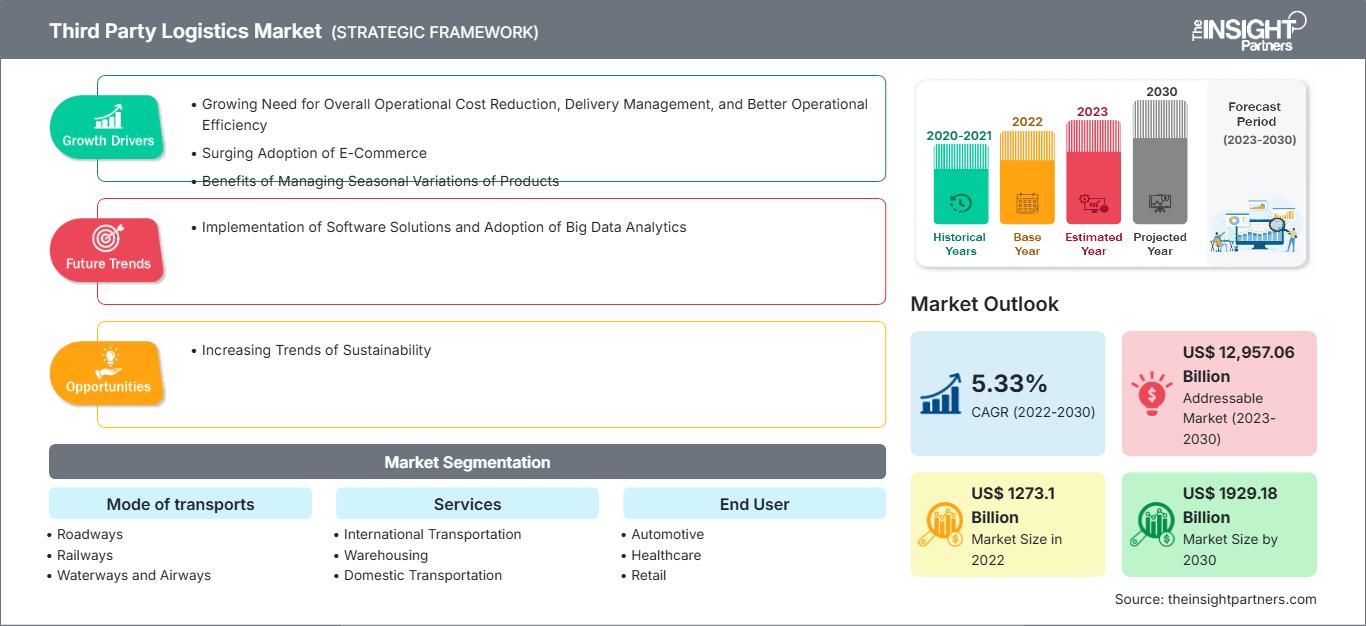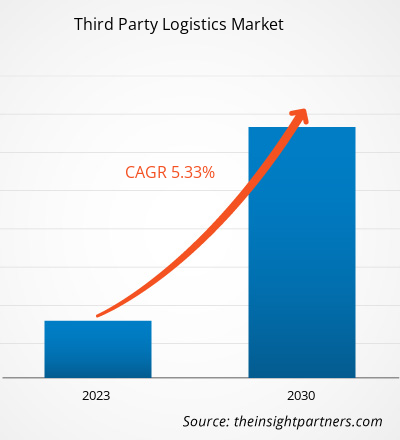El mercado de logística de terceros se valoró en US$ 1273,1 mil millones en 2022 y se proyecta que alcance los US$ 1929,18 mil millones para 2030; se espera que registre una CAGR de 5,33% durante 2022-2030.
Es probable que la creciente proliferación del comercio electrónico siga siendo una tendencia clave en el mercado.
Análisis del mercado de logística de terceros
El auge del comercio electrónico y la demanda de entregas en el mismo día o al día siguiente impulsan la demanda de servicios de entrega de última milla. Por ejemplo, el servicio Prime de Amazon ha establecido nuevos estándares de entrega rápida, lo que ha impulsado a los 3PL a adaptar sus servicios para cumplir con estas expectativas. La creciente concienciación sobre los problemas ambientales y la sostenibilidad ha generado una mayor demanda de soluciones logísticas ecológicas. Los proveedores 3PL están adoptando vehículos eléctricos, optimizando rutas para reducir emisiones e implementando prácticas de embalaje sostenibles para cumplir con las expectativas de los consumidores y las normativas.
Descripción general del mercado de logística de terceros
El transporte de productos manufacturados desde las fábricas hasta los almacenes es la primera etapa del proceso 3PL. La empresa 3PL almacena el producto una vez que llega al almacén o centro logístico. Los productos se almacenan según su SKU, y cada SKU tiene su propio espacio de almacenamiento asignado. Los artículos que entran al almacén normalmente se registran en el sistema de seguimiento del proveedor en este punto. La integración de software facilita procesos eficientes y eficaces.
Obtendrá personalización en cualquier informe, sin cargo, incluidas partes de este informe o análisis a nivel de país, paquete de datos de Excel, así como también grandes ofertas y descuentos para empresas emergentes y universidades.
Mercado de logística de terceros: perspectivas estratégicas

-
Obtenga las principales tendencias clave del mercado de este informe.Esta muestra GRATUITA incluirá análisis de datos, desde tendencias del mercado hasta estimaciones y pronósticos.
Impulsores y oportunidades del mercado de logística de terceros
Beneficios de gestionar las variaciones estacionales de los productos para favorecer el mercado
Las empresas de logística de terceros cuentan con redes de recursos ampliadas que ayudan a las empresas líderes a expandirse de forma eficiente y rentable. Además, pueden ofrecer recursos y flexibilidad suficientes en los servicios para el inventario estacional o el lanzamiento de nuevos productos. Muchos establecimientos experimentan variaciones estacionales en las preferencias de los clientes, por lo que es fundamental gestionar estas fluctuaciones para mantener la eficiencia y satisfacer la demanda.
Aplicación de soluciones de software y adopción de análisis de big data
También se espera que la adopción de dispositivos con RFID almacene datos para facilitar el transporte, lo que a su vez simplificará el seguimiento y la identificación de los productos. El software relacionado con los sistemas de gestión del transporte reducirá la ineficiencia y los costos. Además, el uso de software de reconocimiento de voz en las comunicaciones de los sistemas de gestión de almacenes facilitará la gestión de pedidos y el registro de inventario, a la vez que reducirá la necesidad de capacitación de los empleados. Asimismo, la adopción de la tecnología basada en la nube en las organizaciones logísticas de terceros responderá a las demandas al reconocer la necesidad de acceso de los clientes, lo que les permitirá abordar mejor las tendencias estacionales.
Análisis de segmentación del informe de mercado de logística de terceros
Los segmentos clave que contribuyeron a la derivación del análisis del mercado de logística de terceros son el modo de transporte, los servicios y los usuarios finales.
- Según el modo de transporte, el mercado de logística de terceros se divide en carretera, ferrocarril, vías navegables y aéreas. El segmento de carreteras tuvo una mayor cuota de mercado en 2023.
- Según los servicios, el mercado de logística de terceros se divide en transporte internacional, almacenamiento, transporte nacional, gestión de inventario, entre otros. El segmento de transporte nacional tuvo una mayor participación de mercado en 2023.
- Según los usuarios finales, el mercado de logística de terceros se divide en automoción, salud, comercio minorista, bienes de consumo, etc. Este segmento tuvo una mayor participación de mercado en 2023.
Análisis de la cuota de mercado de la logística de terceros por geografía
El alcance geográfico del informe del mercado de logística de terceros se divide principalmente en cinco regiones: América del Norte, Asia Pacífico, Europa, Medio Oriente y África, y América del Sur y Central.
El informe del mercado de logística de terceros abarca Norteamérica (EE. UU., Canadá y México), Europa (Rusia, Reino Unido, Francia, Alemania, Italia y el resto de Europa), Asia Pacífico (Corea del Sur, India, Australia, Japón, China y el resto de Asia Pacífico), Oriente Medio y África (Arabia Saudita, Sudáfrica, Emiratos Árabes Unidos y el resto de Oriente Medio y África), y Sudamérica y Centroamérica (Argentina, Brasil y el resto de Sudamérica y Centroamérica). En términos de ingresos, Asia Pacífico dominó la cuota de mercado de logística de terceros en 2023. Europa es el segundo mayor contribuyente al mercado global de logística de terceros, seguida de Norteamérica.
Perspectivas regionales del mercado de logística de terceros
Los analistas de The Insight Partners han explicado detalladamente las tendencias regionales y los factores que influyen en el mercado de logística de terceros durante el período de pronóstico. Esta sección también analiza los segmentos y la geografía del mercado de logística de terceros en Norteamérica, Europa, Asia Pacífico, Oriente Medio y África, y Sudamérica y Centroamérica.
Alcance del informe del mercado de logística de terceros
| Atributo del informe | Detalles |
|---|---|
| Tamaño del mercado en 2022 | US$ 1273.1 mil millones |
| Tamaño del mercado en 2030 | US$ 1929.18 mil millones |
| CAGR global (2022-2030) | 5,33% |
| Datos históricos | 2020-2021 |
| Período de pronóstico | 2023-2030 |
| Segmentos cubiertos |
Por modo de transporte
|
| Regiones y países cubiertos |
América del norte
|
| Líderes del mercado y perfiles de empresas clave |
|
Densidad de actores del mercado de logística de terceros: comprensión de su impacto en la dinámica empresarial
El mercado de logística de terceros está creciendo rápidamente, impulsado por la creciente demanda del usuario final debido a factores como la evolución de las preferencias del consumidor, los avances tecnológicos y un mayor conocimiento de los beneficios del producto. A medida que aumenta la demanda, las empresas amplían su oferta, innovan para satisfacer las necesidades del consumidor y aprovechan las tendencias emergentes, lo que impulsa aún más el crecimiento del mercado.

- Obtenga una descripción general de los principales actores clave del mercado de logística de terceros
Noticias y desarrollos recientes del mercado de logística de terceros
El mercado de logística de terceros se evalúa mediante la recopilación de datos cualitativos y cuantitativos tras una investigación primaria y secundaria, que incluye importantes publicaciones corporativas, datos de asociaciones y bases de datos. A continuación, se enumeran algunos de los avances en el mercado de logística de terceros:
- DB Schenker, uno de los principales proveedores de servicios logísticos del mundo, y USA Truck, proveedor líder de soluciones de capacidad, anunciaron un acuerdo según el cual DB Schenker adquirirá todas las acciones ordinarias en circulación de USA Truck por 31,72 dólares por acción en efectivo. La transacción le cuesta a USA Truck aproximadamente 435 millones de dólares, incluyendo efectivo y deuda asumidos. (Fuente: DB Schenker, comunicado de prensa, julio de 2022)
- Deutsche Post DHL Group, la empresa de logística líder a nivel mundial, anunció hoy que cambiará su nombre a "DHL Group" a partir del 1 de julio de 2023. El nuevo nombre refleja la transformación que ha experimentado el Grupo en los últimos años y rinde homenaje a su enfoque en las actividades logísticas nacionales e internacionales como motor de su crecimiento futuro. (Fuente: DHL Group, comunicado de prensa, julio de 2023)
Cobertura y resultados del informe de mercado de logística de terceros
El informe "Tamaño y pronóstico del mercado de logística de terceros (2020-2030)" proporciona un análisis detallado del mercado que abarca las siguientes áreas:
- Tamaño del mercado de logística de terceros y pronóstico a nivel global, regional y nacional para todos los segmentos clave del mercado cubiertos bajo el alcance
- Tendencias del mercado de logística de terceros, así como dinámicas del mercado, como impulsores, restricciones y oportunidades clave
- Análisis PEST y FODA detallado
- Análisis del mercado de logística de terceros que cubre las tendencias clave del mercado, el marco global y regional, los principales actores, las regulaciones y los desarrollos recientes del mercado.
- Análisis del panorama industrial y de la competencia que abarca la concentración del mercado, el análisis de mapas de calor, los actores destacados y los desarrollos recientes para el mercado de logística de terceros.
- Perfiles detallados de empresas
- Análisis histórico (2 años), año base, pronóstico (7 años) con CAGR
- Análisis PEST y FODA
- Tamaño del mercado, valor/volumen: global, regional y nacional
- Industria y panorama competitivo
- Conjunto de datos de Excel
Informes recientes
Informes relacionados
Testimonios
Razón para comprar
- Toma de decisiones informada
- Comprensión de la dinámica del mercado
- Análisis competitivo
- Información sobre clientes
- Pronósticos del mercado
- Mitigación de riesgos
- Planificación estratégica
- Justificación de la inversión
- Identificación de mercados emergentes
- Mejora de las estrategias de marketing
- Impulso de la eficiencia operativa
- Alineación con las tendencias regulatorias






















 Obtenga una muestra gratuita para - Mercado de logística de terceros
Obtenga una muestra gratuita para - Mercado de logística de terceros